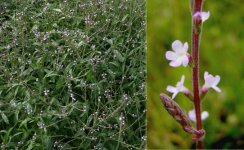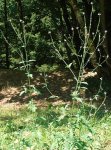Verbena medicinal - verbena officinalis l.
Family Verbena - Verbenaceae



Botanical characteristics. Perennial herbaceous plant. The root is powerful. Stem straight, branched, covered with hairs on the sides. Leaves ovate or oblong, at base wedge-narrowed, sessile; Middle leaves coarse toothed with dull teeth, upper - oblong, entire. The flowers are numerous, collected in long spicate inflorescence inflorescences such as panicles. Corolla is light purple. Fruits - oblong-linear, dvuhranno-convex, wrinkled, brown or brownish nutlets. Blossoms in June - July, fructifies in August - September.
Spread. It grows in meadows, forest edges, along the banks of rivers and seas, along gorges, beams, in gardens, near roads, among crops.
Used parts of the plant. Medicinal raw materials are leaves, flowers, roots, less often seeds. Roots are harvested in spring or autumn, dried outdoors or in dryers at a temperature of no higher than 30 ° C. The aerial part of the plant is collected during flowering, the fruits - as they mature.
Chemical composition. All parts of the plant contain iridoidy (verbenolin, aukubin, hastasid), steroids (sitosterol), triterpenoids (lupeol, ur-salt acid), flavonoids (artemetin), essential oil, vitamins, trace elements.
Application. It has a toning and restorative effect, is used for hypotension, loss of strength, anemia, poor menstruation in women with asthenic physique. In folk medicine, decoctions of the aboveground part of the plant are used for fever, headache, liver disease, spleen, atherosclerosis, thrombosis, as a cardiotonic agent, in metabolic disorders, anemia, as restorative, diuretic, lactogenic; Externally - with rashes, scrofula; In the form of baths - with scabies, bruises; With diseases of the oral cavity, scrofullosis, hepatitis.
In Chinese, Korean and Tibetan medicine, verbena is used as an antitumor agent for tumors of the genital organs, as a diaphoretic, with ulcers, eczema.
In India, verbena drugs are used as a contraceptive, which is confirmed in the experiment. The roots in Turkmenistan, Moldova, and the Caucasus are used for marinades and pickles.
Preparation. To get the broth, take 20 g of raw materials, grind, pour 200 ml of boiling water, insist on a boiling water bath for 30 minutes, cool for 10 minutes, filter. Take 2 tbsp. Spoons 3-4 times a day, regardless of food intake.
Contraindications. Some authors consider the plant to be poisonous.


Comments
When commenting on, remember that the content and tone of your message can hurt the feelings of real people, show respect and tolerance to your interlocutors even if you do not share their opinion, your behavior in the conditions of freedom of expression and anonymity provided by the Internet, changes Not only virtual, but also the real world. All comments are hidden from the index, spam is controlled.